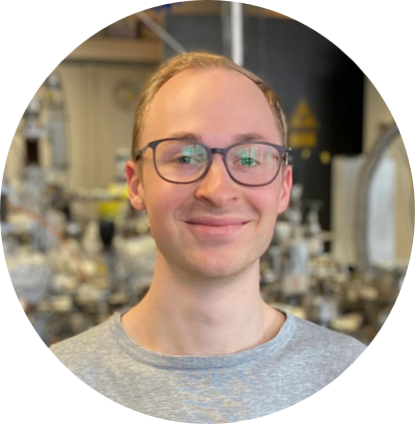The low concentrations of the reactants present in the UHV in the TPD enable the illumination of the reaction mechanisms on a molecular scale. However, under technically feasible catalysis conditions, further information on the collective reaction behavior and aging processes is necessary to make a statement about the effectiveness of the catalysis cycles.
Currently, the stability and reaction behavior of small and medium-sized cluster catalysts under technical conditions is unknown. For this reason, a so-called high-pressure cell is being developed and used. In this high-pressure cell, the surface covered with catalyst material can be examined at pressures between a few millibars and up to two bars.
As a prototype system, the Sabatier reaction on copper clusters fixed on various metal oxides is chosen. This system is particularly relevant for environmental and economic reasons, as it can be used for CO2 cyclization in industrial processes and thus as a new feedstock for higher-value chemicals.
With the help of this research project, the existing gap between basic research on cluster catalysts and their application in the technical process is to be reduced in the future.
Literature
J. Ott, V. Gronemann, F. Pontzen, E. Fiedler, G. Grossmann, D. B. Kersebohm, G. Weiss, C. Witte, Ullmann's Encyclopedia of Industrial Chemistry, Wiley-VCH Verlag GmbH & Co. KGaA, 2000.
P. Kaiser, R. B. Unde, C. Kern, A. Jess, Chem. Ing, Tech. 2013, 85, 489.
D. Kim, C. S. Kley, Y. Li, P. Yang, P. Natl. A. Sci. 2017, 114, 10560.
Achieving independence from fossil fuels is a major challenge of our time.
The conventional dehydrogenation from alkane to alkene is a very energy-intensive process and therefore not sustainable and economically feasible. A possible alternative is the production of alkenes from alkanes by oxidative dehydrogenation. Atomically prepared nanoclusters on oxidic surfaces are promising catalysts for this purpose, since their properties can be influenced by adding or removing an atom. For this purpose, in this project oxidic surfaces are grown on silicon single crystals and subsequently deposited with a monodispersive nanocluster distribution. The samples are then characterised by transmission electron microscopy, Auger electron and X-ray photoelectron spectroscopy. Finally, the catalytic activity of the system is investigated in a temperature-programmed experiment to establish a correlation between the physical and chemical properties as a function of the nanocluster size.
Literature
B. Fu, J. Lu, P. C. Stair, G. Xiao, M. C. Kung, H. H. Kung, J. Catal. 2013, 297, 289-295.
H. Zhu, H. Dong, P. Laveille, Y. Saih, V. Caps, J. M. Basset, Catal. Today 2014, 228, 58-64.
R. Koirala, R. Buechel, F. Krumeich, S. E. Pratsinis, A. Baiker, ACS Catal. 2015, 5, 690-702.
In the age of regenerative energies, the conversion to a hydrogen-based energy network represents an opportunity for sustainable energy management. In order to realize this, environmentally friendly and inexpensive processes for hydrogen production are necessary. The sun as a globally available energy source offers an ideal starting point. For this reason, our research is concerned with the basic understanding of alternative catalysts.
For this purpose, the catalytic properties of small supported metal clusters (e.g. platinum) on titanium dioxide and silicon are investigated as model systems for end layers of current tandem solar cells. Of particular interest are effects that can be attributed to different cluster sizes and thus reflect the abrupt changes in the chemical and physical properties of clusters.
The analysis of the surfaces is mainly done by photoelectron spectroscopy, electrochemical measurements and temperature programmed desorption in combination with imaging techniques.
Literature
X. Cheng, Y. Li, L. Zheng, Y. Yan, Y. Zhang, G. Chen, S. Sun, J. Zhang, Energy Environ. Sci. 2017, 10, 2450.
D. Wang, Z. Liu, W. Yang, ACS Catal. 2018, 8, 7270-7278.
F. Neuberger, J. Baranyai, T. Schmidt, T. Cottre, B. Kaiser, W. Jaegermann, R. Schäfer, Z. Phys. Chem. 2019, 1-19.








